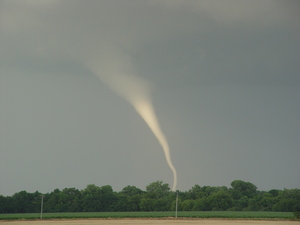From advances in weather prediction, to learning about our past, to treatments for rare diseases, these five discoveries of the last ten years will change the very world we live in.
Amazing Discovery #1: Geostationary Satellites
In 2011, over 550 people in the United States died as a result of tornadoes. This is almost as many as the previous ten years combined. The weather is getting stronger. The Geostationary Satellite will make monitoring these weather conditions easier and more accurate.
Geostationary Satellites, known as GOES, are satellites that rotate at a speed matching the earth’s rotation. From about 22, 300 miles up, the satellite is able to hover continuously over one spot. This allows a “full-disc” view of the planet, looking for patterns that lead to severe weather. For example, to predict tornadoes, the satellites will monitor changes in lightning patterns and hail-producing clouds. The satellite is aimed at increasing warning time for tornadoes and other severe weather, such as flash floods.
Amazing Discovery #2: Yuka
Yuka is the nickname given a young wooly mammoth carcass discovered in Siberia in 2012. Yuka was about two and a half years old when it died, roughly 10,000 years ago. The carcass was mostly intact, but scientists were able to learn a lot from what the carcass was missing. The missing pieces prove that Yuka was butchered by humans. Even more exciting to scientists is the condition of the body itself. There is enough remaining to clone the mammoth, and to date Yuka is the most well-preserved mammoth specimen found. Yuka can possibly answer questions about how early humans hunted and lived, and perhaps help scientists to understand how mammoths went extinct in the first place.
Amazing Discovery #3: The Milwaukee Protocol
Until 2005, rabies was always fatal. The Milwaukee Protocol changed this prognosis. In late 2004, fifteen year old Jeanna Geise of Wisconsin was bitten by a bat. She thought nothing of it, so did not seek medical attention. More than a month later, she came down with rabies. She was treated with a process that became known as The Milwaukee Protocol. The doctors working on Jeanna’s case put her into a medically induced coma, gave her anti-viral medication, and waited for her brain’s own defenses to take over. She was discharged from the hospital, rabies-free, on January 1, 2005. Jeanna was the first person ever to recover from full-blown rabies. The availability of this treatment has saved another 3 lives in the years since. While Rabies in pets is declining due to the vaccine, it continues to grown in the wild animal population, especially in bats. Rabid bats are found in 48 of 50 states (no cases have been reported in Alaska or Hawaii) and almost all domestically acquired rabies cases come from bats.
Amazing Discovery #4: A new Earth?
Maybe. In September 2010, scientists announced the discovery of Gliese 581g This is the first planet of the right size in the so called “Goldilocks” zone-the area that is close enough to a star without being too close-that makes a planet capable of supporting liquid water. The size of this planet makes it possible that it could have an atmosphere. This “just right” planet took a lot of time to find. Scientists scoured the skies for 11 years before they discovered Gliese 581g. This discovery opens the door to future space travel to such a planet, and a possibility of finding an answer to one of the oldest questions: is there life out there?
Amazing Discovery #5: Zombie Ants
Seriously. Scientists in 2011 discovered a rare group of fungi, , Ophiocordyceps unilateralis, which can literally take over the mind of an ant. The fungi cause the ants to travel to a new location, which is perfect for the fungi to spread its spores. Once the fungi reaches this ideal environment, it quickly kills the ant. This information, besides giving us nightmares, will help scientists understand how this fungus spreads, and may even shed some light on Global Warming.
These discoveries may sound far fetched–in some cases, downright disturbing–but they all have the possibility to teach us more about our would and about ourselves.



